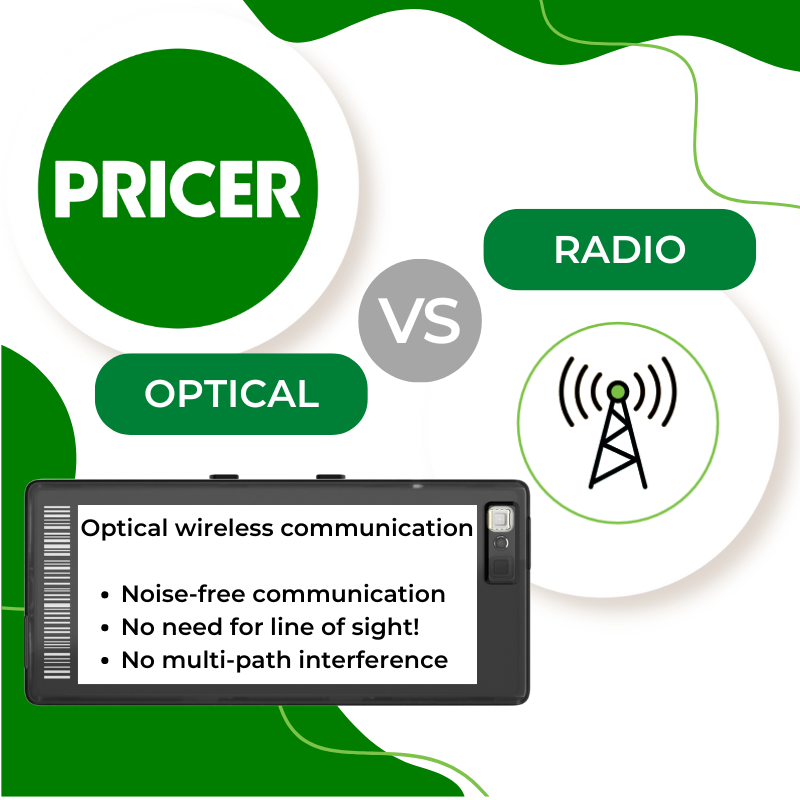Optical wireless communication and radio communication have a lot in common, but there are a few physical differences!
Noise-Free Optical Spectrum
The main difference is that the optical spectrum (880 nm) is almost noise-free. Unlike radio systems, which suffer from interference with other signals, WiFi networks, and devices, the optical spectrum remains largely uncontested. Radio frequencies, particularly the commonly used 868MHz and 2.4GHz bands, are extremely crowded. These frequencies are shared with numerous other devices and systems, leading to potential disruptions. A transmission that works flawlessly at one moment might fail the next due to this congestion.
No Need for Line of Sight
The optical solution is designed to communicate using reflected, diffused light. This means there is no need for a direct line of sight for effective communication. Unlike radio signals, which can be blocked by obstacles like metal shelving, people, or even dog food, optical communication can penetrate these barriers effortlessly.

Noise-Free Communication
Optical communication can coexist with current and future radio systems such as Wi-Fi and mobile networks (3G, 4G & 5G), alarm systems, Bluetooth, etc., without causing or suffering from interference. This means it is entirely free from communication pollution, ensuring consistent and reliable performance in any environment.
Power Efficiency and High Bandwidth
Optical wireless communication is extremely power-efficient. It enables high bandwidth, with communication speeds that aren’t hampered by the need for constant retransmissions and lost packets, as seen in radio frequency systems. As data demands increase with high-resolution displays and the introduction of new technologies, radio systems struggle, but optical systems maintain high transmission success rates, often around 98%.
Super Power-Efficient
Because optical wireless communication is more power-efficient, it allows for the design of highly responsive systems. For example, a Pricer label checks communication every second, whereas a radio frequency label may need to sleep for 15 seconds to several minutes, making real-time services like click-and-collect difficult to implement. Optical systems support sub-second responses without significant battery drain.

Optical wireless communication and radio communication have a lot in common, but there are a few physical differences!
Noise-Free Optical Spectrum
The main difference is that the optical spectrum (880 nm) is almost noise-free. Unlike radio systems, which suffer from interference with other signals, WiFi networks, and devices, the optical spectrum remains largely uncontested. Radio frequencies, particularly the commonly used 868MHz and 2.4GHz bands, are extremely crowded. These frequencies are shared with numerous other devices and systems, leading to potential disruptions. A transmission that works flawlessly at one moment might fail the next due to this congestion.
No Need for Line of Sight
The optical solution is designed to communicate using reflected, diffused light. This means there is no need for a direct line of sight for effective communication. Unlike radio signals, which can be blocked by obstacles like metal shelving, people, or even dog food, optical communication can penetrate these barriers effortlessly.
Noise-Free Communication
Optical communication can coexist with current and future radio systems such as Wi-Fi and mobile networks (3G, 4G & 5G), alarm systems, Bluetooth, etc., without causing or suffering from interference. This means it is entirely free from communication pollution, ensuring consistent and reliable performance in any environment.
Power Efficiency and High Bandwidth
Optical wireless communication is extremely power-efficient. It enables high bandwidth, with communication speeds that aren’t hampered by the need for constant retransmissions and lost packets, as seen in radio frequency systems. As data demands increase with high-resolution displays and the introduction of new technologies, radio systems struggle, but optical systems maintain high transmission success rates, often around 98%.
Super Power-Efficient
Because optical wireless communication is more power-efficient, it allows for the design of highly responsive systems. For example, a Pricer label checks communication every second, whereas a radio frequency label may need to sleep for 15 seconds to several minutes, making real-time services like click-and-collect difficult to implement. Optical systems support sub-second responses without significant battery drain.

Social Media